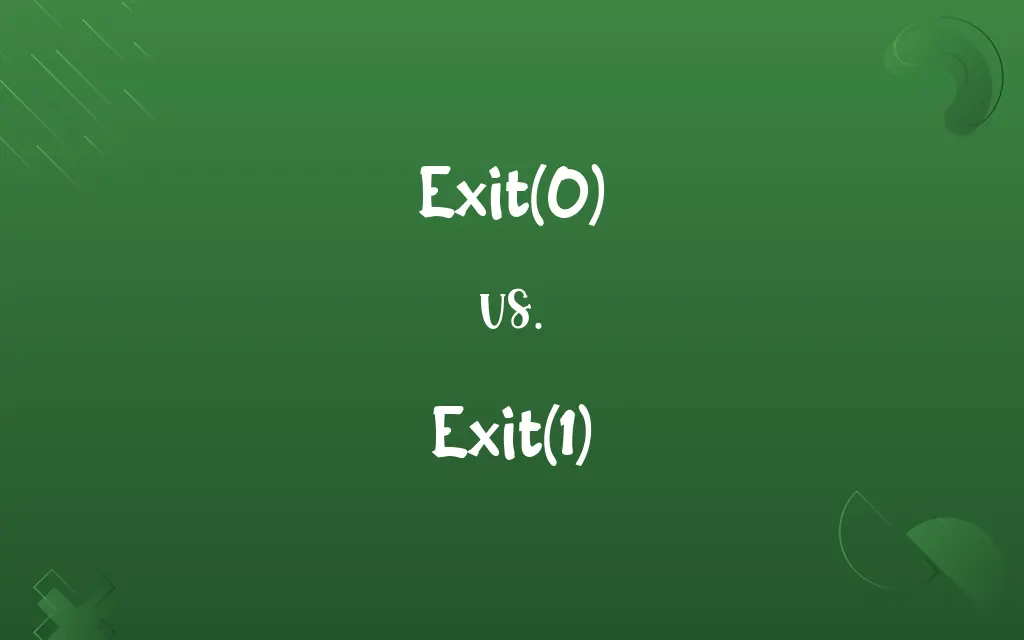Exit(0) vs. Exit(1): Know the Difference

By Shumaila Saeed || Published on February 2, 2024
Exit(0) indicates successful program termination, whereas Exit(1) signals an error or abnormal termination.

Key Differences
Exit(0) is commonly used in programming to denote successful completion of a program. It signals to the operating system that all processes have been executed correctly without errors. Conversely, Exit(1) is used to indicate that the program has encountered an error or an exceptional situation that prevents it from completing its tasks as intended.
Shumaila Saeed
Feb 02, 2024
In many programming environments, Exit(0) is the standard method for a program to communicate to the operating system that it has finished its execution as expected. On the other hand, Exit(1) typically signifies an abnormal termination, often triggered by a runtime error or a specific condition not being met within the program.
Shumaila Saeed
Feb 02, 2024
The use of Exit(0) is common in scenarios where a program completes its tasks successfully, such as processing a file without issues. In contrast, Exit(1) might be used when a program fails to find a required file, encounters a data input it cannot process, or runs into a critical internal error.
Shumaila Saeed
Feb 02, 2024
Exit(0) and Exit(1) are integral to error handling in programming. While Exit(0) confirms that no further action is needed, Exit(1) can trigger error handling routines, log generation, or other diagnostic responses to investigate and address the issue.
Shumaila Saeed
Feb 02, 2024
It's important to note that while Exit(0) and Exit(1) are the most common, other non-zero exit codes (like Exit(2), Exit(3), etc.) can be used to convey specific types of errors or statuses, providing more granular control over program termination.
Shumaila Saeed
Feb 02, 2024
ADVERTISEMENT
Comparison Chart
Termination Status
Indicates successful completion.
Signals an error or abnormal termination.
Shumaila Saeed
Feb 02, 2024
Common Usage
Used for normal program termination.
Used when the program encounters an error.
Shumaila Saeed
Feb 02, 2024
Operating System Signal
Implies no errors to the OS.
Suggests a problem or exception to the OS.
Shumaila Saeed
Feb 02, 2024
Error Handling
Typically requires no error handling.
Often triggers error handling routines.
Shumaila Saeed
Feb 02, 2024
Program Flow Impact
Marks the end of a successful path.
May indicate an early or unexpected exit.
Shumaila Saeed
Feb 02, 2024
ADVERTISEMENT
Exit(0) and Exit(1) Definitions
Exit(0)
Exit(0) marks the end of a program’s execution without issues.
The application completed its task and returned Exit(0).
Shumaila Saeed
Jan 24, 2024
Exit(1)
Exit(1) signifies an error or problem in the program.
Due to a missing file, the program returned Exit(1).
Shumaila Saeed
Jan 24, 2024
Exit(0)
Exit(0) communicates to the operating system that everything went as planned.
Upon successful installation, the installer executed Exit(0).
Shumaila Saeed
Jan 24, 2024
Exit(1)
Exit(1) is used when a program can’t complete its intended tasks.
If the network is unreachable, the script exits with Exit(1).
Shumaila Saeed
Jan 24, 2024
Exit(0)
Exit(0) indicates no errors occurred in the program.
After processing all files correctly, the program used Exit(0).
Shumaila Saeed
Jan 24, 2024
ADVERTISEMENT
Exit(1)
Exit(1) indicates abnormal or unsuccessful program termination.
The application encountered a runtime error and used Exit(1).
Shumaila Saeed
Jan 24, 2024
Exit(0)
Exit(0) is a standard code for normal program termination.
Once the user inputs were validated, the script returned Exit(0).
Shumaila Saeed
Jan 24, 2024
Exit(1)
Exit(1) often triggers error handling or diagnostic processes.
The unexpected exception caused an Exit(1) from the application.
Shumaila Saeed
Jan 24, 2024
Exit(0)
Exit(0) signifies successful program completion.
The script ran without errors, so it executed Exit(0).
Shumaila Saeed
Jan 24, 2024
Exit(1)
Exit(1) signals to the operating system that an error occurred.
After failing the integrity check, the software exited with Exit(1).
Shumaila Saeed
Jan 24, 2024
Repeatedly Asked Queries
What does Exit(0) indicate in programming?
It indicates successful program completion.
Shumaila Saeed
Feb 02, 2024
Does Exit(1) always mean a critical error?
Not always critical, but it does indicate something went wrong.
Shumaila Saeed
Feb 02, 2024
Can Exit(0) be used in any programming language?
Yes, it’s widely recognized across various programming languages.
Shumaila Saeed
Feb 02, 2024
When is Exit(1) typically used?
When a program encounters an error or abnormal situation.
Shumaila Saeed
Feb 02, 2024
Is Exit(0) considered a good practice?
Yes, it’s a standard for indicating successful completion.
Shumaila Saeed
Feb 02, 2024
What does Exit(1) communicate to the operating system?
It signals that the program terminated with an issue.
Shumaila Saeed
Feb 02, 2024
In which scenarios is Exit(0) commonly used?
In scenarios where a program successfully completes its tasks.
Shumaila Saeed
Feb 02, 2024
Does Exit(1) require immediate attention?
It often does, especially if it indicates a significant error.
Shumaila Saeed
Feb 02, 2024
Is Exit(0) necessary in every program?
It’s a common practice but not always mandatory.
Shumaila Saeed
Feb 02, 2024
Can Exit(1) be customized for specific errors?
Yes, programmers can use different non-zero values for specific errors.
Shumaila Saeed
Feb 02, 2024
How does the operating system respond to Exit(0)?
It generally assumes the program completed without issues.
Shumaila Saeed
Feb 02, 2024
Is Exit(0) the same across different operating systems?
Generally, yes, it has the same meaning in different environments.
Shumaila Saeed
Feb 02, 2024
What type of error handling is associated with Exit(1)?
It can trigger logs, alerts, or specific error-handling routines.
Shumaila Saeed
Feb 02, 2024
How does Exit(1) aid in program debugging?
It helps identify points of failure or unexpected behavior in the program.
Shumaila Saeed
Feb 02, 2024
Can Exit(1) be a part of normal program flow?
It’s usually not part of normal flow, but rather an exception.
Shumaila Saeed
Feb 02, 2024
What best practices surround the use of Exit(0)?
Using it to clearly signify successful completion and clean termination.
Shumaila Saeed
Feb 02, 2024
Can Exit(1) vary in meaning based on the program?
Yes, its interpretation can depend on the program’s context.
Shumaila Saeed
Feb 02, 2024
Can Exit(0) be followed by other operations in a program?
Typically no, as it signifies the end of the program's execution.
Shumaila Saeed
Feb 02, 2024
How do developers use Exit(1) effectively?
By using it to indicate and diagnose errors in the program.
Shumaila Saeed
Feb 02, 2024
Is Exit(0) a universal standard?
Yes, it’s universally understood in programming for successful exit.
Shumaila Saeed
Feb 02, 2024
Share this page
Link for your blog / website
HTML
Link to share via messenger
About Author
Written by
Shumaila SaeedShumaila Saeed, an expert content creator with 6 years of experience, specializes in distilling complex topics into easily digestible comparisons, shining a light on the nuances that both inform and educate readers with clarity and accuracy.








































































